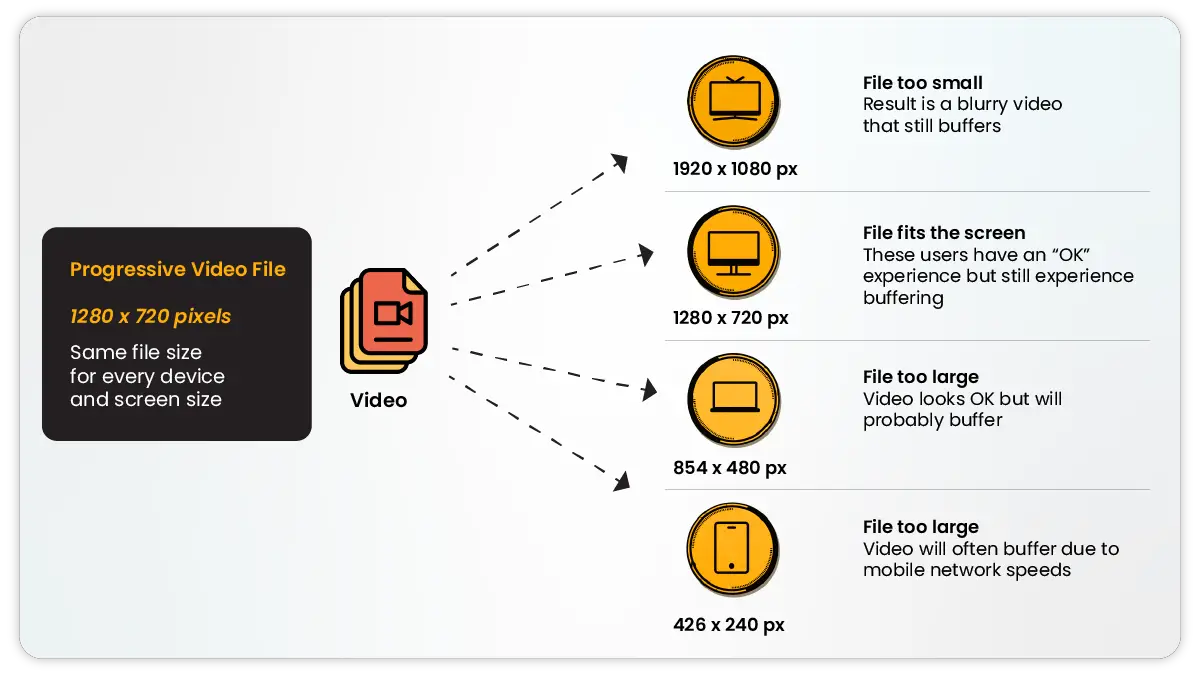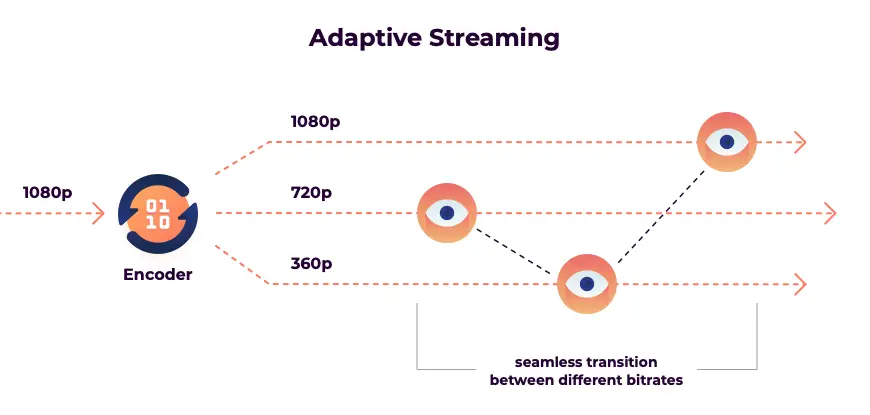Enhancing User Experience with Adaptive Bitrate Streaming in CDNs

Introduction

Adaptive Bitrate Streaming (ABR) is a critical technology in Content Delivery Networks (CDNs) that enables video and audio content to be delivered to end-users at varying bitrates to optimize video quality and minimize buffering. This article explores how ABR enhances user experience in CDNs.

How ABR Works
- Video Segmentation: Video content is divided into small segments of varying quality.
- Bitrate Adaptation: The CDN analyzes the user’s network conditions (e.g., bandwidth, latency) and selects the most appropriate bitrate for each segment.
- Dynamic Buffering: The CDN predicts future network conditions and buffers multiple segments to minimize the risk of buffering interruptions.
Benefits of ABR in CDNs
1. Improved Video Quality: ABR ensures that users receive video at the highest possible quality their network can support, without compromising stability.
2. Reduced Buffering: By dynamically adapting the bitrate, ABR minimizes buffering interruptions, providing a seamless viewing experience.
3. Bandwidth Optimization: ABR ensures efficient bandwidth utilization by delivering only the bitrate necessary for each user’s network conditions.
4. Device Agnostic Experience: ABR adapts to different devices and network capabilities, delivering an optimized experience on smartphones, tablets, laptops, and TVs.
5. Low Latency: CDNs with low-latency architectures enable faster bitrate adaptation, reducing the delay between the user’s network changes and the corresponding bitrate adjustments.
Implementation Considerations
- CDN Capabilities: CDNs should provide robust ABR support, including advanced encoding algorithms, adaptive buffering techniques, and real-time network monitoring.
- Content Preparation: Video content should be segmented and encoded at multiple bitrates to support ABR.
- Player Integration: Video players must support ABR by incorporating bitrate selection algorithms and buffering mechanisms.
Metrics for Evaluating ABR Performance
- Bitrate Adaptation Time: Time taken for the CDN to adjust the bitrate in response to network changes.
- Buffering Ratio: Percentage of time spent buffering relative to total playback time.
- Playback Quality: Subjective ratings of video quality, including smoothness, sharpness, and lack of artifacts.
Conclusion
Adaptive Bitrate Streaming in CDNs significantly enhances user experience by delivering optimized video quality, reducing buffering, and ensuring seamless playback across various devices and network conditions. By leveraging advanced ABR techniques and robust CDNs, content providers can deliver captivating and uninterrupted video content to their audiences.## Enhancing User Experience With Adaptive Bitrate Streaming In Cdns
Executive Summary
Adaptive bitrate streaming (ABR) is a video delivery technology that allows video content to be streamed at different bitrates, adapting to the viewer’s network conditions. This technology has become increasingly important in content delivery networks (CDNs), as it can help to improve the user experience by reducing buffering and rebuffering.
Introduction
ABR works by dividing the video content into small chunks, each of which is encoded at a different bitrate. When a viewer requests the video, the CDN will select the chunk that is most appropriate for the viewer’s network conditions. If the viewer’s network conditions improve, the CDN will switch to a higher bitrate chunk, providing the viewer with a better quality video experience. If the viewer’s network conditions deteriorate, the CDN will switch to a lower bitrate chunk, preventing the video from buffering or rebuffering.
FAQ
1. What are the benefits of using ABR in CDNs?
- Improved user experience: ABR can help to reduce buffering and rebuffering, providing a smoother and more enjoyable video experience for viewers.
- Increased viewer engagement: By providing a better quality video experience, ABR can help to increase viewer engagement and reduce churn.
- Reduced CDN costs: ABR can help to reduce CDN costs by reducing the amount of bandwidth required to deliver video content.
2. How does ABR work in CDNs?
ABR works by dividing the video content into small chunks, each of which is encoded at a different bitrate. When a viewer requests the video, the CDN will select the chunk that is most appropriate for the viewer’s network conditions. If the viewer’s network conditions improve, the CDN will switch to a higher bitrate chunk, providing the viewer with a better quality video experience. If the viewer’s network conditions deteriorate, the CDN will switch to a lower bitrate chunk, preventing the video from buffering or rebuffering.
3. What are the challenges of using ABR in CDNs?
One of the challenges of using ABR in CDNs is managing the trade-off between video quality and bandwidth usage. If the CDN selects a bitrate that is too high, it may result in buffering or rebuffering. If the CDN selects a bitrate that is too low, it may result in a poor quality video experience for the viewer.
Subtopics
1. Video Quality
Video quality is one of the most important factors to consider when using ABR. The quality of the video will depend on the bitrate at which it is streamed. A higher bitrate will result in a better quality video, but it will also require more bandwidth.
- Bitrate: The bitrate of a video is measured in kilobits per second (kbps). The higher the bitrate, the better the quality of the video.
- Resolution: The resolution of a video is measured in pixels. The higher the resolution, the sharper the video image will be.
- Frame rate: The frame rate of a video is measured in frames per second (fps). The higher the frame rate, the smoother the video will appear.
2. Network Conditions
Network conditions can have a significant impact on the quality of the video experience. If the viewer’s network is congested or unreliable, it may result in buffering or rebuffering.
- Bandwidth: The bandwidth of a network is measured in megabits per second (Mbps). The higher the bandwidth, the more data can be transferred over the network.
- Latency: The latency of a network is measured in milliseconds. The lower the latency, the faster data can be transferred over the network.
- Packet loss: Packet loss is a measure of the percentage of data packets that are lost in transit. The higher the packet loss, the more likely it is that the video will buffer or rebuffer.
3. Buffering
Buffering occurs when the video player has to pause playback in order to download more data. Buffering can be caused by a number of factors, including network congestion, high latency, and packet loss.
- Buffer size: The buffer size is the amount of data that the video player has downloaded and stored. The larger the buffer size, the less likely it is that the video will buffer.
- Buffer fullness: The buffer fullness is the percentage of the buffer that is currently full. The higher the buffer fullness, the less likely it is that the video will buffer.
- Buffer threshold: The buffer threshold is the percentage of the buffer that must be full before the video player will start playing. The lower the buffer threshold, the more likely it is that the video will buffer.
4. Rebuffering
Rebuffering occurs when the video player has to stop playback and start over from the beginning. Rebuffering can be caused by a number of factors, including network congestion, high latency, and packet loss.
- Rebuffering time: The rebuffering time is the amount of time that it takes for the video player to start playing again after a rebuffering event.
- Rebuffering frequency: The rebuffering frequency is the number of times that the video player has to rebuffer.
- Rebuffering impact: The rebuffering impact is the negative impact that rebuffering has on the user experience.
5. Metrics
There are a number of metrics that can be used to measure the performance of ABR. These metrics include:
- Video quality: The quality of the video can be measured by the bitrate, resolution, and frame rate.
- Network conditions: The network conditions can be measured by the bandwidth, latency, and packet loss.
- Buffering: Buffering can be measured by the buffer size, buffer fullness, and buffer threshold.
- Rebuffering: Rebuffering can be measured by the rebuffering time, rebuffering frequency, and rebuffering impact.
Conclusion
ABR is a powerful technology that can be used to improve the user experience of video streaming. By adapting to the viewer’s network conditions, ABR can help to reduce buffering and rebuffering, providing a smoother and more enjoyable video experience.
Keyword Tags
- Adaptive bitrate streaming
- Content delivery networks
- Video quality
- Network conditions
- Buffering
- Rebuffering
